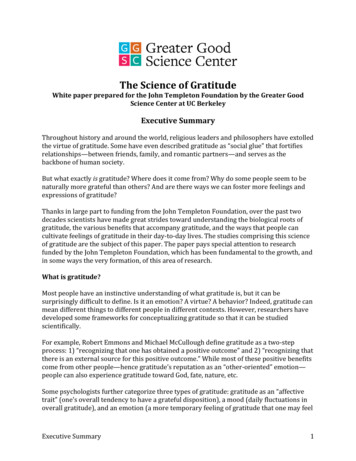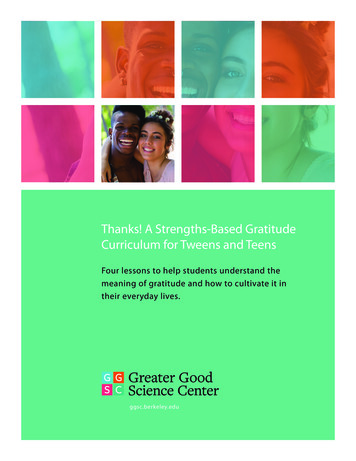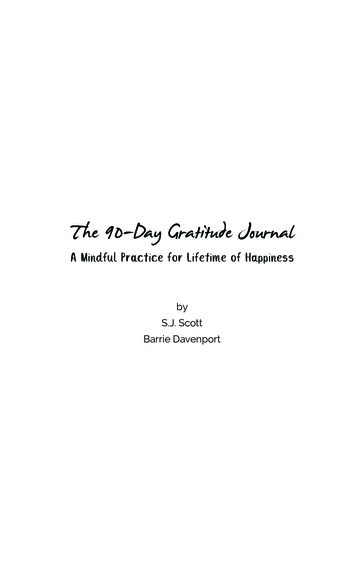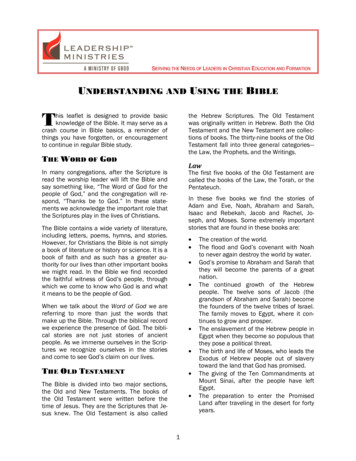
Transcription
The Science of GratitudeWhite paper prepared for the John Templeton Foundation by the Greater GoodScience Center at UC BerkeleyExecutive SummaryThroughout history and around the world, religious leaders and philosophers have extolledthe virtue of gratitude. Some have even described gratitude as “social glue” that fortifiesrelationships—between friends, family, and romantic partners—and serves as thebackbone of human society.But what exactly is gratitude? Where does it come from? Why do some people seem to benaturally more grateful than others? And are there ways we can foster more feelings andexpressions of gratitude?Thanks in large part to funding from the John Templeton Foundation, over the past twodecades scientists have made great strides toward understanding the biological roots ofgratitude, the various benefits that accompany gratitude, and the ways that people cancultivate feelings of gratitude in their day-to-day lives. The studies comprising this scienceof gratitude are the subject of this paper. The paper pays special attention to researchfunded by the John Templeton Foundation, which has been fundamental to the growth, andin some ways the very formation, of this area of research.What is gratitude?Most people have an instinctive understanding of what gratitude is, but it can besurprisingly difficult to define. Is it an emotion? A virtue? A behavior? Indeed, gratitude canmean different things to different people in different contexts. However, researchers havedeveloped some frameworks for conceptualizing gratitude so that it can be studiedscientifically.For example, Robert Emmons and Michael McCullough define gratitude as a two-stepprocess: 1) “recognizing that one has obtained a positive outcome” and 2) “recognizing thatthere is an external source for this positive outcome.” While most of these positive benefitscome from other people—hence gratitude’s reputation as an “other-oriented” emotion—people can also experience gratitude toward God, fate, nature, etc.Some psychologists further categorize three types of gratitude: gratitude as an “affectivetrait” (one’s overall tendency to have a grateful disposition), a mood (daily fluctuations inoverall gratitude), and an emotion (a more temporary feeling of gratitude that one may feelExecutive Summary1
after receiving a gift or a favor from someone). Most of the studies in this paper focus ontrait (or “dispositional” gratitude) and/or gratitude as an emotion.The origins of gratitudeResearch suggests that gratitude is not simply a cultural construct. It has deep roots thatare embedded in our evolutionary history, our brains and DNA, and in child development.Animals as diverse as fish, birds, and vampire bats engage in “reciprocal altruism”activities—behaviors that one animal performs to help another member of their species,even at a cost to themselves, presumably because they recognize at some instinctual levelthat the other individual may repay the favor at a later date. Many scientists see this desireto repay generosity as an expression of gratitude. In fact, some scientists suggest thatgratitude may have evolved as a mechanism to drive this reciprocal altruism, therebyturning strangers into friends and allies who are more likely to help one another.Support for the idea that gratitude may have arisen as an evolutionary adaptation comes inpart from research on primates. Studies have found that chimpanzees are more likely toshare food with a chimpanzee that had groomed them earlier in the day and are more likelyto help another chimpanzee with a task if that chimpanzee had helped them in the past.Studies from neuroscience have identified brain areas that are likely involved inexperiencing and expressing gratitude, providing further evidence for the idea thatgratitude is an intrinsic component of the human experience. Additionally, a few studieshave identified specific genes that may underlie our ability to experience gratitude.Recent studies have also begun exploring the developmental roots of gratitude. This worksuggests that even fairly young children have some concept of gratitude that develops asthey mature. Again, this suggests that the roots of gratitude run deep.Individual factors linked to gratitudeEven if humans as a species have a general propensity for gratitude, what determineswhether an individual feels grateful or not? Research has linked a variety of factors—including personality factors, cognitive factors, and gender—to one’s likelihood ofexperiencing gratitude or having a grateful disposition.Several studies have explored whether certain personality factors—such as extraversion,agreeableness, conscientiousness, neuroticism, or openness to experience—are associatedwith dispositional gratitude; their results have differed. Other studies have found evidencesuggesting that gratitude may be conceptualized as its own personality factor.There are a number of cognitive factors that can influence how much gratitude a personfeels in a certain situation. These include the perceived intentions of the benefactor (i.e.,whether the benefactor was seen as acting out of pure altruism or due to selfish motives,such as wishing to improve their reputation), the apparent cost to the benefactor, theExecutive Summary2
perceived value of the gift/favor to the recipient, whether the gift/favor was provided bychoice versus obligation, and the extent to which the receiver believes in free will.Several studies have found that girls and women report feeling more grateful than boysand men, possibly because boys and men—at least in the United States—may be morelikely to associate gratitude with weakness or indebtedness.Other studies have identified certain traits that act as barriers to gratitude. These includeenvy, materialism, narcissism, and cynicism.Social and cultural factors linked to gratitudeResearch also suggests that social factors—including religion, cultural influences, andparenting styles—may influence a person’s tendency to experience gratitude.Multiple studies report associations between elements of religiosity/spirituality anddispositional gratitude, suggesting that there may be a link between religion and gratitude.One study found that people assigned to pray for their partner, or pray in general, for fourweeks reported higher gratitude at the end of the study than people who were assigned tothink about their daily activities or to think positive thoughts about their partner. However,another study found that priming people to think about religious concepts did not increasetheir gratitude or generosity.Culture may also influence people’s experiences of gratitude. For example, one study foundthat men in the United States reported experiencing gratitude less frequently than those inGermany, and another study found that American, Brazilian, Chinese, and Russian childrendiffered in the ages and extent to which they expressed different forms of gratitude.A few studies have looked at how parents might influence their children’s gratitudeexperiences. For example, a study of fourth and fifth grade students and their biologicalparents found a small but statistically significant relationship between the self-reportedgratitude of the children and their mothers, but not between the children and their fathers.Another study explored why more grateful parents might have more grateful children,finding that more dispositionally grateful parents were more likely to place their childrenin situations that might evoke feelings of gratitude, such as volunteering for people in need.Individual benefits of gratitudeResearch suggests that gratitude may be associated with many benefits for individuals,including better physical and psychological health, increased happiness and lifesatisfaction, decreased materialism, and more.A handful of studies suggest that more grateful people may be healthier, and others suggestthat scientifically designed practices to increase gratitude can also improve people’s healthand encourage them to adopt healthier habits.Executive Summary3
Many more studies have examined possible connections between gratitude and variouselements of psychological well-being. In general, more grateful people are happier, moresatisfied with their lives, less materialistic, and less likely to suffer from burnout.Additionally, some studies have found that gratitude practices, like keeping a “gratitudejournal” or writing a letter of gratitude, can increase people’s happiness and overallpositive mood.Gratitude may also benefit people with various medical and psychological challenges. Forexample, one study found that more grateful cardiac patients reported better sleep, lessfatigue, and lower levels of cellular inflammation, and another found that heart failurepatients who kept a gratitude journal for eight weeks were more grateful and had reducedsigns of inflammation afterwards. Several studies have found that more grateful peopleexperience less depression and are more resilient following traumatic events.Other studies suggest that gratitude may live up to its reputation as “the mother of allvirtues” by encouraging the development of other virtues such as patience, humility, andwisdom.In recent years, studies have examined gratitude’s potential benefits for children andadolescents. For example, studies have found that more grateful adolescents are moreinterested and satisfied with their school lives, are more kind and helpful, and are moresocially integrated. A few studies have found that gratitude journaling in the classroom canimprove students’ mood and that a curriculum designed to help students appreciate thebenefits they have gained from others can successfully teach children to think moregratefully and to exhibit more grateful behavior (such as writing more thank you notes totheir school’s PTA).Social benefits of gratitudeGiven its role as “social glue,” it should not be surprising that evidence points to gratitude’ssocial benefits as well. Research suggests that gratitude inspires people to be moregenerous, kind, and helpful (or “prosocial”); strengthens relationships, including romanticrelationships; and may improve the climate in workplaces.Several studies have supported the link between gratitude and prosocial behavior. Thesestudies have found that more grateful people are more helpful and generous and thatexperimentally manipulating people’s feelings of gratitude can lead them to be morehelpful and generous—as can activities such as writing a gratitude letter.Gratitude is also important to forming and maintaining social relationships. Researchsupports what some researchers refer to as the “find, remind, and bind” function ofgratitude: By attuning people to the thoughtfulness of others, gratitude helps them “find” oridentify people who are good candidates for quality future relationships; it also helps“remind” people of the goodness of their existing relationships; and it “binds” them to theirpartners and friends by making them feel appreciated and encouraging them to engage inbehaviors that will help prolong their relationships. For example, one study found thatExecutive Summary4
participants who were thanked for helping a student on an assignment were moreinterested in affiliating with that student in the future; another study found that partnerswho had a series of conversations expressing gratitude to their partner reported moreimprovements in their personal well-being and in the well-being of their relationship thandid partners who had conversations disclosing something personal about themselves.Though there has not been a great deal of research explicitly focused on gratitude in theworkplace, a handful of studies suggest that gratitude may help employees perform theirjobs more effectively, feel more satisfied at work, and act more helpfully and respectfullytoward their coworkers.Gratitude interventionsAs mentioned earlier, a growing number of studies have tested the efficacy of variouspractices (“interventions”) designed to boost gratitude, such as counting one’s blessings(gratitude journaling) and writing letters of gratitude to people whom one has neverproperly thanked (“gratitude letters). These studies have helped to identify many of thebenefits of gratitude described above. But results from these studies also suggest how somepeople might be more likely to engage with, and benefit from, certain gratitudeinterventions.For starters, some studies have identified factors that influence whether people are willingto adopt and/or complete these interventions. For example, people who are naturally morecurious are more likely to give gratitude interventions a try.Other studies have found evidence that some people may be more likely to benefit fromgratitude interventions than others. For example, one study found that less neurotic peoplereported increased happiness a week after completing a gratitude intervention, but moreneurotic participants did not.A series of meta-analysis studies have attempted to determine the efficacy of gratitudeinterventions, and most have concluded that gratitude interventions do appear tosignificantly increase happiness, well-being, and positive mood. However, the impact ofthese interventions on many other outcomes is less clear.Future directionsResearch on the science of gratitude is relatively new, and thus there are still many openquestions left to explore. These include studies looking at the potential dark sides ofgratitude (e.g., manufacturing gratitude to manipulate people), further defining andcategorizing different types of gratitude experiences, determining why some interventionswork for some people but not others, and identifying how best to use gratitudeinterventions in the classroom and the workplace.Executive Summary5
Table of nWhat is Gratitude?Origins of GratitudeIndividual Factors Linked to GratitudeSocial and Cultural Factors Linked to GratitudeIndividual Benefits Associated with GratitudeSocial Benefits Associated with GratitudeGratitude InterventionsLimitations and Future DirectionsReferencesTable of ContentsPage 7Page 9Page 14Page 19Page 23Page 27Page 41Page 51Page 56Page 596
I.IntroductionAccording to Cicero, gratitude is more than “the greatest virtue,” it is also “the mother of allother remaining virtues.”In many respects, research supports this sentiment. The experience of gratitudeencourages us to appreciate what is good in our lives and compels us to pay this goodnessforward. People with more grateful dispositions report being happier and more satisfiedwith their lives. Gratitude also functions as social glue that nurtures the formation of newfriendships, enriches our existing relationships, and underlies the very foundation ofhuman society.But what exactly is gratitude? Where does gratitude come from? Why do some people seemto be naturally more grateful than others? And are there ways we can further cultivate ourfeelings of gratitude? These questions and others will be explored in this paper.This paper presents an overview of the science of gratitude, a relatively new field, focusingon papers published in the last 20 years; during that time, the number of studies ofgratitude has increased significantly. These studies primarily emanate from the disciplineof psychology, although relevant studies from other fields—including neuroscience,ecology, sociology, and medicine—will also be discussed. This paper conveys the extent towhich funding from the John Templeton Foundation has been fundamental to the growth,and in some ways the very formation, of this area of psychological research.The number of citations for a paper (as of September 2017) is indicated in brackets [ ] nextto the paper’s citation; highly cited studies ( 50 citations) are in bold. Citations of studiesfunded by grants from the John Templeton Foundation are shown in blue (thus highly citedJTF-funded studies are shown with bolded blue citations).A few caveats should be kept in mind while reading this paper:1. How frequently studies have been cited can differ by academic discipline, subfield,and publication date. In some research areas (e.g., social psychology), researcherstypically publish many articles each year while in others (e.g., neuroscience) theymay only publish a few. Thus determining whether a particular study has beeninfluential requires considering the context of its publication, such as its field andthe year it was published. Because many studies covering the science of gratitudewere published relatively recently, the true impact of these studies on the field maynot be discernable for several years.2. Partly because research on gratitude is relatively new, some of the findings cited inthis paper stem from single studies. Results from a single study, especially studieswith small numbers of participants, should be considered with caution (Ioannidis,2005) [5037] (Marszalek, Barber, Kohlhart, & Cooper, 2011) [75]. Attempts toIntroduction7
replicate some findings from psychology (Klein et al., 2014) [309](Open ScienceCollaboration, 2015) [1278] have failed, casting some doubt on the validity ofthese findings; however, the extent to which these findings were not actuallyreplicated (Gilbert, King, Pettigrew, & Wilson, 2016) [126] (Anderson et al.,2016) [127] (Patil, Peng, & Leek, 2016) [17] and the reasons for the lack ofreproducibility (Etz & Vandekerckhove, 2016) [43] have been subjects of debateand discussion. As much as possible, this paper will discuss findings that have beenreplicated or generally supported by multiple studies, including meta-analyses thatboth combine data across multiple experiments and reanalyze these data. However,because a main goal of this white paper is to give a sense of the breadth of researchon gratitude to date, particularly that which has been supported by JTF, findingshave not been omitted simply because they have not yet been replicated; instead,some of these studies have been included to suggest new possibilities and directionsin the research. When these findings have been supported by only a single study sofar, we have tried to make that clear within the text.The paper is divided into nine main sections, including this introductory section. The nextsection briefly defines gratitude and includes a short history of the science of gratitude. Thethird explores gratitude’s evolutionary, biological, and developmental roots. The fourthsection focuses on the individual factors that may influence a person’s propensity toexperience gratitude, while the fifth section focuses on the social and cultural factors thatinfluence people’s experiences and expressions of gratitude. The sixth and seventh sectionsdiscuss the individual and social benefits of gratitude, respectively, including its possiblebenefits for health, happiness, and relationships. The eighth section discusses variousscientifically designed gratitude activities (“interventions”) that researchers havedeveloped in order to increase people’s feelings and expressions of gratitude. The finalsection outlines some limitations to this research and presents promising future directionsin the science of gratitude.Introduction8
II.What is Gratitude?A. Defining GratitudeReligious traditions including Judaism, Christianity, Islam, Buddhism, and Hinduism allencourage cultivating gratitude as an important moral virtue. For millennia, gratitude hasbeen a popular topic among philosophers: Cicero said gratitude “is not only the greatest one but also the mother of all the otherremaining virtues”;Seneca “ranked ingrates below thieves, rapists and adulterers”;Hume wrote, “Of all crimes that human creatures are capable of committing, themost horrid and unnatural is ingratitude”;and Adam Smith believed that gratitude was vital for maintaining a society based ongoodwill (Emmons & Crumpler, 2000) [484], (McCullough, Kilpatrick, Emmons,& Larson, 2001) [1134], (Manela, 2015).Thus gratitude infuses our religious, cultural, and scholarly traditions, which generallymaintain that gratitude is important for a person to be good and moral and a citizen of theworld. But what exactly is gratitude? It depends on whom you ask.“Gratitude has been conceptualized as an emotion, a virtue, a moral sentiment, a motive, acoping response, a skill, and an attitude. It is all of these and more,” write Robert Emmonsand Cheryl Crumpler in a 2000 paper that examined the empirical research on gratitude(Emmons & Crumpler, 2000) [484]. Similarly, studies surveying attitudes aboutgratitude among the general public have reported a wide range of gratitude experiences(Lambert, Graham, & Fincham, 2009) [151] (Hlava & Elfers, 2013) [12] (Elfers & Hlava,2016) [0]. Thus, gratitude can mean different things to different people in differentcontexts.Yet in their influential 2003 paper, Emmons and Michael McCullough posit that gratitudecan be generally distilled to a two-step cognitive process: 1) “recognizing that one hasobtained a positive outcome” and 2) “recognizing that there is an external source for thispositive outcome” (Emmons & McCullough, 2003) [2376]. Because many of our benefitscome from other people, gratitude is often thought of as an interpersonal or other-orientedemotion. However, Emmons and McCullough assert, people can also experience gratitudetoward God, animals, fate, coincidence, nature, the weather, avoiding a mistake, and more.Furthermore, there is evidence that gratitude can be thought of as an emotional experiencewith three hierarchical levels: affective trait, mood, and emotion. These three levels ofgratitude can influence one another. Affective traits, as defined by psychologist ErikaRosenberg, are “stable predispositions toward certain types of emotional responding”(Rosenberg, 1998) [522]. Thus, some people may have a more grateful disposition.Moods, according to Rosenberg, “wax and wane, fluctuating throughout or across days.”What is Gratitude?9
And emotions are more short-term reactions to particular events—for example, feelinggrateful after receiving a gift.A study of this hierarchical model of gratitude concluded that “grateful moods are createdboth through top-down effects (i.e., the effects of personality and affective traits), bottomup effects (i.e., the effects of discrete interpersonal and emotional episodes), and theinteraction of these effects” (McCullough, Tsang, & Emmons, 2004) [487]. This studyfound that grateful moods set the stage for more frequent and pervasive grateful emotions,yet people with more trait gratitude were more resistant to fluctuations in their dailygrateful moods or emotions caused by particular events.Many of the studies covered in this paper discuss trait gratitude (also called “dispositionalgratitude”), while others focus on gratitude as an emotion or mood. Whenever possible, wetry to note the type of gratitude being examined in a particular study.B. A Brief History of the Science of GratitudeWhile conceptualizing gratitude has historically been an area of interest for philosophersand religious scholars, until recently it had received considerably less attention fromscientists. A handful of sociologists and psychologists conducted foundational work onconceptualizing gratitude as a phenomenon that could be defined and studied (Simmel,1950) [5608], (Schwartz, 1967) [590], (Gouldner, 1960) [11509], (Heider, 1958)[23233], (Weiner & Graham, 1989) [135], (Lazarus & Lazarus, 1994) [829], (Ortony,Clore, & Collins, 1988) [7556]. But research on how people benefit from gratitude, andways to cultivate it, were not particularly popular topics of study until Robert Emmons,Michael McCullough, and colleagues published a series of landmark papers, reporting onthe results of research largely funded by the John Templeton Foundation, in the early2000s (McCullough et al., 2001) [1134].Since then, and thanks in large part to JTF-funded efforts such as the Expanding the Scienceand Practice of Gratitude (ESPG) project, the field of gratitude research has blossomed.According to the PsycINFO database, in 2000, when JTF was just beginning to fund studiesof gratitude, only three peer reviewed papers published that year listed “gratitude” as amajor subject or keyword; that number grew to 21 papers published in 2008; and to 111published in 2015. Further evidence that JTF funding has been fundamental to the growthof the field comes from the large number of papers that have cited Emmons andMcCullough’s early gratitude papers; for example, more than 1,100 works reference their2001 paper, “Is gratitude a moral affect?”; their 2003 study, “Counting blessings versusburdens: An experimental investigation of gratitude and subjective well-being in daily life,”has garnered more than 2,300 citations.C. How Gratitude Relates to Other EmotionsSeveral studies have examined how gratitude relates to other emotions. Importantly,studies have found that gratitude and indebtedness (or obligation)—concepts that wereoften previously considered overlapping constructs—can sometimes be experimentallyWhat is Gratitude?10
separated (Goei & Boster, 2005) [81]. For example, studies have found that people feelsignificantly more grateful when they know a helper has benevolent intentions than when afavor is given due to ulterior motives (Tsang, 2006b) [146], and a recipient’s gratitudedecreases and indebtedness increases when their benefactor expresses a greaterexpectation of repayment (Watkins, Scheer, Ovnicek, & Kolts, 2006) [253]. Additionally,more self-focused people tend to experience more indebtedness and less gratitude(Mathews & Green, 2010) [45].Other studies have attempted to distinguish gratitude from other positive emotions, suchas elevation, the emotion that one feels when witnessing moral actions (Haidt, 2000)[260] (Fredrickson, 2004) [491]. Work by Sara Algoe and Jonathan Haidt, for example,suggests that the three “other-praising emotions”—elevation, gratitude, and admiration—can be separated based on the outcomes that these emotions motivate: “elevation (aresponse to moral excellence) motivates prosocial and affiliative behavior, gratitudemotivates improved relationships with benefactors, and admiration motivates selfimprovement” (Algoe & Haidt, 2009) [575].Gratitude is also often conflated with appreciation. One study defines appreciation as“acknowledging the value and meaning of something—an event, a person, a behavior, anobject—and feeling a positive emotional connection to it” and treats gratitude as one ofeight key facets of appreciation: “The gratitude aspect of appreciation refers to noticing andacknowledging a benefit that has been received, whether from another person or deity, andfeeling thankful for the efforts, sacrifices, and actions of an ‘other’” (Adler & Fagley, 2005)[401]. Another study found that appreciation “made a significant unique contribution tolife satisfaction” after controlling for both other personality factors and trait gratitude, aresult that suggests appreciation may be worthy of further consideration in its own right,independent of gratitude. However, yet another study found that people’s levels ofappreciation and their dispositional gratitude levels are highly correlated with oneanother; this result suggests that appreciation and gratitude may be too interrelated to beconsidered separate traits (Wood, Maltby, Stewart, & Joseph, 2008) [163]. Thus thescientific distinctions between appreciation and gratitude are still a matter of debate anddiscussion.D. Methods for Measuring GratitudeIn order to truly study gratitude, one needs to be able to measure it. Thus, the burgeoninginterest in gratitude research in psychology over the past few decades has beenaccompanied by the development of questionnaires and surveys to quantify gratitude, themost popular of which are discussed below.The Gratitude Adjective Checklist (GAC)The Gratitude Adjective Checklist is a simple survey that asks people to report on a 1-5scale how much they have felt each of the following adjectives: 1) Grateful, 2) Thankful, and3) Appreciative (McCullough, Emmons, & Tsang, 2002) [1798]. A person’s GAC score isWhat is Gratitude?11
the sum of those numbers. Because of the general nature of this measure, it can be used tomeasure gratitude as an emotion, a mood, or a disposition by limiting people to report theirlevels of the three adjectives within a certain time period (now, in the last few weeks, or ingeneral).The Gratitude Questionnaire-6 (GQ-6)The Gratitude Questionnaire-6 (GQ-6) was designed to measure a person’s level ofgratitude as an affective trait or disposition, their so-called “trait gratitude” (McCulloughet al., 2002) [1798]. This is the full GQ-6 (items 3 and 6 are reverse scored):The Gratitude Questionnaire–6 (GQ-6)Using the scale below as a guide, write a number beside each statement to indicatehow much you agree with it. 1 strongly disagree 2 disagree 3 slightly disagree4 neutral 5 slightly agree 6 agree 7 strongly agree1. I have so much in life to be thankful for.2. If I had to list everything that I felt grateful for, it would be a very long list.3. When I look at the world, I don’t see much to be grateful for.4. I am grateful to a wide variety of people.5. As I get older I find myself more able to appreciate the people, events, andsituations that have been part of my life history.6. Long amounts of time can go by before I feel grateful to something orsomeone.The GQ-6 has been used to measure trait gratitude in many of the studies cited in thispaper. A Chinese version of the GQ-6 was validated in a study of Taiwanese undergraduates(L. H. Chen, Chen, Kee, & Tsai, 2009) [86].The Gratitude Resentment and Appreciation Test (GRAT)The Gratitude Resentment and Appreciation Test (GRAT) is another survey used tomeasure trait gratitude (Watkins, Woodward, Stone, & Kolts, 2003) [628]. Similar to theGQ-6, participants are asked to rate their agreement or disagreement with a series ofstatements such
Executive Summary 1 . The Science of Gratitude White paper prepared for the John Templeton Foundation by the Greater Good Science Center at UC Berkeley . Executive Summary . Throughout history and around the world, religious leader










